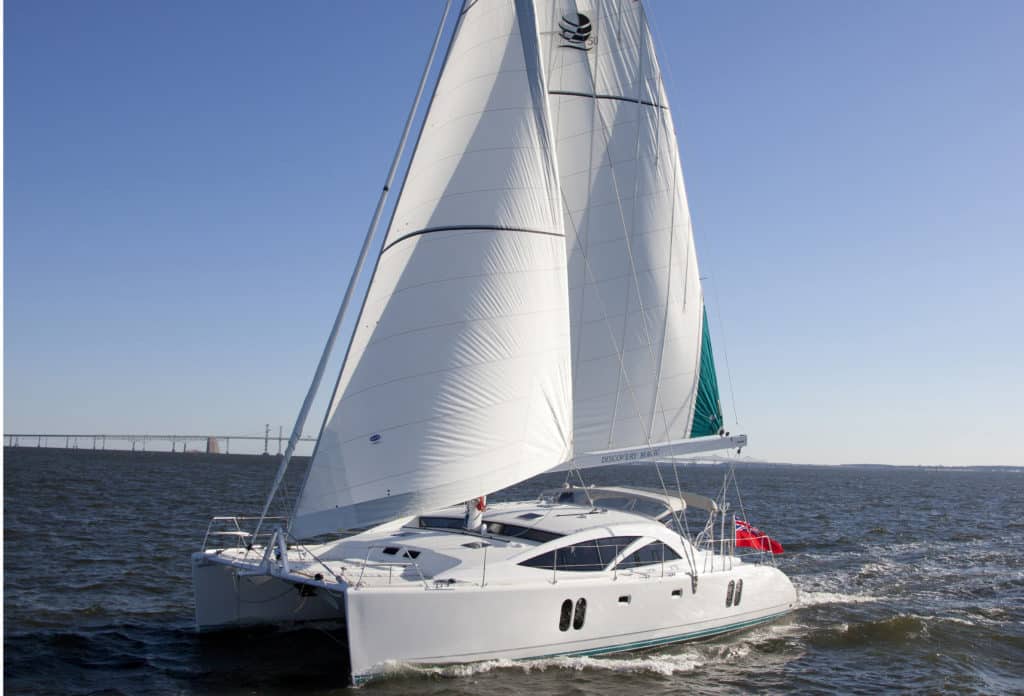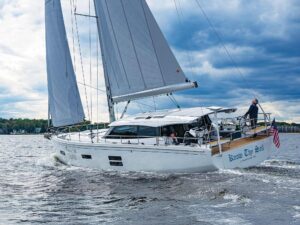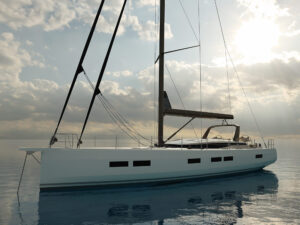
Discovery 50
We were in the Gulf Stream about 300 miles offshore. The water temperature was about 90 F. There wasn’t a breath of wind. The sea was pancake flat and well over two miles deep. And since the still air felt almost as hot as the sea, we all agreed it was time for a swim. So while the carefree crew made up of Caroline Charnley, Donald Brewster, and myself took the plunge into the deep, deep blue, our captain, John Charnley, dutifully stayed aboard to make sure the boat didn’t drift away as we splashed in the stream like schoolchildren. I’d signed up with John and Caroline, the founders of Discovery Yachts, based in Southampton, England, to help them sail their Discovery 50 catamaran last summer from Bermuda up to Newport, Rhode Island, but the story of how the Charnleys came to start a successful boatbuilding company and finally be able to go on an extended cruise aboard a boat they built began decades before.
Business Builder
As often is the case with successful entrepreneurs, John’s career has taken more than a few twists and turns. He learned to fly as an officer in the Royal Marines in the late 1960s, and he went on to be a commercial airline pilot in the 1970s. But his first love was sailing, and when a currency crisis in England forced the government to restrict the amount of money citizens would be allowed to take out of the country, thus giving birth to the new concept of airfare-inclusive “package holidays,” he saw an opportunity to start a business that did the same for those wishing to charter a boat in the Greek Islands.
In four years, while flying full-time during the first two years, he built the company, Sunsail—yes, that Sunsail—up from four boats in Greece to 110 boats in charter bases all over Europe and the Caribbean. As Sunsail took off, he finally stopped flying so he’d be able to prepare for and compete in the 1980 Observer Singlehanded Transatlantic Race along with running the growing company.
He sold Sunsail to brewing giant Guinness in 1981. “I was tired,” he told me in his characteristic understated way at dinner during our passage. “I wanted to take some time off.” Who wouldn’t need some time off after all that? But his rest was short-lived. He soon went on to found, then sell a company that built over 250 Swift 18 trailer-sailers. He also bought land in the Meon Valley of Hampshire, England, that he and Caroline—she was one of Sunsail’s first staff in Greece, and they were married in 1982—would devote to viticulture under the label of Wickham Vineyard.
For the next 16 years, they worked to build the vineyard from the ground up. It was hard, physical labor, and in time, the wine they produced received rave reviews.
But around John’s 50th birthday, they realized that they might want to spend less time tending grapes and steam-cleaning wine casks and more time visiting the places where John had stopped all too briefly when he was flying around the world for a living. For them, there was only one way to do that: on their own boat. But as they searched for the perfect vessel to take them around the world, nothing available seemed quite right.
They didn’t fully intend to become builders again when they commissioned Ron Holland to design an offshore-capable monohull to their exact specifications. But they did have a female mold built so it’d be possible to sell subsequent models. Ever the businessman, John’s idea was that they’d market what eventually became the Discovery 55 to a few people looking for something different in an offshore cruising boat, and they’d subcontract out the construction so they’d have time to go cruising. But it didn’t work out that way.
I first met John and Caroline in 2001 when I was in England to test-sail the new Discovery 55 on the cold, gray water of the Solent. The boat was impressive, and it soon became apparent to all concerned that more than just a few people would want to take a boat like that around the world. So instead of heading off cruising and subcontracting out the construction of a few boats a year, the Charnleys constructed in Southampton a boatbuilding facility capable of satisfying the demand; suddenly, they were full-time hands-on business owners, not full-time cruisers. The well-established company now builds a 67-foot monohull in addition to the 55, but John and Caroline never forgot the reason they started the company in the first place. But when the time was right to step back from the day-to-day running of the company and finally go cruising, the couple came to an interesting conclusion: It would be aboard a catamaran. And thus it was that we found ourselves sailing a Discovery 50 up to Newport.
Two-Hulled Discovery
“With all the success you’ve had building monohulls,” I asked John while we were sitting around the saloon during our passage, “why’d you choose to go cruising on a cat?”
“We decided that the market was definitely ready for a luxury cruising catamaran that a cruising couple could sail around the world,” he said. Then he looked around the large, comfortable saloon with its 360-degree view. “And this interior is pretty comfortable, wouldn’t you agree?” I did.
“Both monohulls and catamarans have their strong points,” he continued. “But we felt that if we could combine on a catamaran the same good looks, good ideas, and quality construction that we’ve been able to deliver with our 55- and 67-footers, we’d have something special.”
The process of designing and building the cat was similar to the other boats that the Charnleys have gone on to build. They hired a brand-name designer—Bill Dixon—to draw the lines and worked closely with him to make sure the Discovery cat would stand out from the crowd of charter cats available today. I saw how they achieved that objective as we motored up to the boat in St. George’s Harbour, in Bermuda. Lots of cruising cats appear somewhat boxy. Some do a better job than others to disguise their high freeboard and slab-sided hulls, but in my opinion, the lines of the Discovery 50 do more than just trick the eye. The proportions are spot on. The large, curved cabin ports integrate into the hulls beautifully and make the boat seem much less top-heavy than other cats I’ve seen. The large, tinted, vertically-oriented ports in the hulls not only allow for plenty of natural light down below; they also give the boat a sleek super-yacht look. But as I found out in the range of conditions we experienced on our trip north, this offshore passagemaker is more than just a looker.
Taking a swim while becalmed in the Gulf Stream was fun, but the passage wasn’t a total drifter. During one of my night watches, I gathered lots of evidence of the boat’s capability to stand up to more substantial offshore conditions while being easily singlehanded. With the wind in the teens, we barreled along at an easy eight to nine knots, speeds less than some lighter, more overtly performance-oriented cats might return, but still faster than some similarly sized monohulls are capable of in such conditions. The reality is this cat puts a higher premium on offshore safety, comfort, and ease of handling than it does on pure speed. So trimming sails with the powered winch, pushing buttons on the autopilot, checking the chart plotter and Automatic Identification System targets, and keeping a lookout from the comfort of the relative protection of the helm seat was a piece of cake. And when the wind piped up into the mid-20s, I did something that I’ve never done before on a 50-foot cruising cat: I reefed the main by myself without waking the off watch for help. Since John specifically called for the boat to be handled easily by a couple, he chose the ease of in-mast furling over a traditional main with its large roach and full battens. I’m sure a traditional main, an available option, would provide more horsepower in light air, and I generally like going as fast as I can on a passage, but I can’t deny the importance, both for safety and peace of mind, that comes with the ability to reef so easily. And that’s a trait a shorthanded cruising couple will appreciate. We probably could’ve carried the full main in those conditions, too, but we were hardly going slow, and as John says, “We’re not racing, and it never hurts to be a bit conservative.”
It was during that night watch that I also came to appreciate the passagemaking functionality of the nav station. Sure, the saloon is big and comfortable, the seat cushions are cushy, and the woodwork is exquisite, but I also noted the ability to stand my watch inside, protected from the elements at the forward-facing nav station while still having a good view out in all directions when a rain shower passed over us. Other commonsense features that any long-range offshore cruiser will like include the large engine rooms aft in each hull that make it really easy to check the oil or change a filter, the excellent systems installation, and the oversized mooring cleats and ground tackle.
Don’t get me wrong: The boat’s workmanlike functionality hardly diminishes the attractiveness, comfort, and craftsmanship of the interior or, as I was already well aware, the decadence of the guest cabins aft. The light woodwork and large opening ports and hatches made my cabin, which was fitted out with a queen-sized bunk—the other guest cabin has two twin bunks—feel bigger, brighter, and airier than some cat cabins I’ve seen, and the innerspring mattress seemed more comfortable than my bed at home. Each guest cabin also has its own well-appointed head. But these accommodations are nothing when compared with the master cabin forward.
This is the only 50-foot cat I’ve seen that has a master cabin running the full width of the boat forward of the mast. It’s a lot easier to simply dedicate a hull to the master cabin. But an owner’s cabin in a hull isn’t quite the same as having a cabin up on the bridgedeck that’s nearly 22 feet wide and also has a separate seating area, a desk/office, and even his-and-her heads.
As my last watch came to a close and the suspension bridge that connects Newport to Conanicut Island came into view over the horizon, I was more than just a little jealous of the Charnleys’ future plans. After sailing across the Atlantic and making our little jaunt up from Bermuda, they were about to shift from passagemaking mode into cruising mode and spend the summer exploring the New England coast. And I had to agree with John when he said that building an attractive, comfortable, offshore-capable catamaran easily handled by a cruising couple could be something special. As we were to learn after the Charnleys sailed the boat from Maine down to Annapolis last fall, CW’s Boat of the Year judges also agreed. They not only named the Discovery 50 the Best Catamaran but also deemed it CW’s overall 2011 Import Boat of the Year.
Of course, that doesn’t mean John and Caroline are in a hurry to return to the day-to-day operations of building boats. They’re still involved with the company and are in close contact with their management team, but by the time this story hits the newsstands, they’ll be doing exactly what they intended to do over a decade ago: sail around the world. When I last heard from them, the Charnleys were transiting the Panama Canal en route to the South Pacific. I hear the water is warm there, too.
Bill Springer is a Boston-based marine writer.








